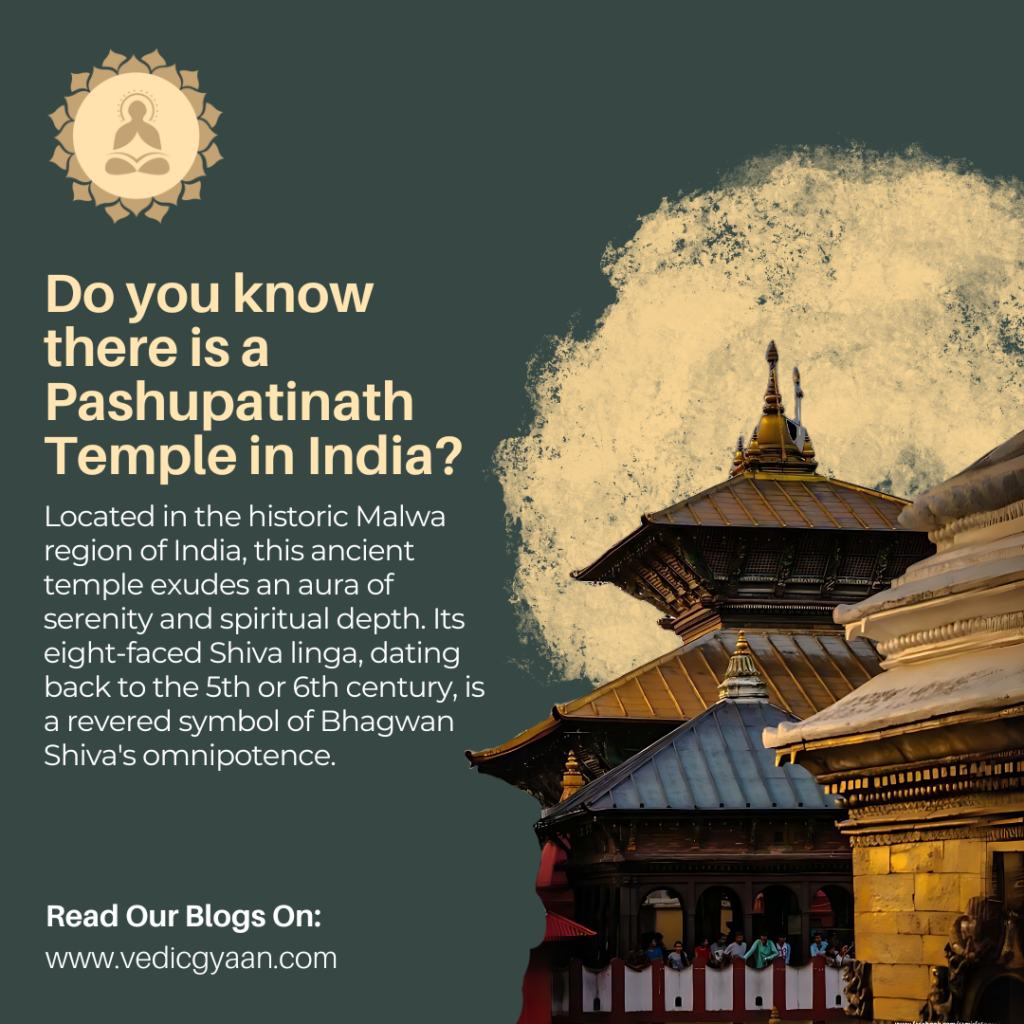Pashupatinath Temple revered as one of the most sacred Hindu pilgrimage sites, stands as a testament to the faith and devotion of its devotees. With its rich history, intricate architecture, and profound spiritual significance, the temple draws visitors from all corners of the globe, seeking solace and enlightenment amidst its hallowed halls.

Two Renowned Pashupatinath Shrines
The world boasts two prominent Pashupatinath temples, each holding a unique position in the hearts of Shiva’s devotees:
- Pashupatinath Temple, Kathmandu, Nepal: Nestled along the banks of the sacred Bagmati River, this UNESCO World Heritage Site stands as a masterpiece of Nepalese architecture. Its golden spires and intricate carvings captivate the senses, while the air resonates with the chants and prayers of pilgrims seeking divine blessings.
- Pashupatinath Temple, Mandsaur, India: Located in the historic Malwa region of India, this ancient temple exudes an aura of serenity and spiritual depth. Its eight-faced Shiva linga, dating back to the 5th or 6th century, is a revered symbol of Bhagwan Shiva’s omnipotence.
Meaning of Pashupatinath
The name “Pashupatinath” carries profound significance, embodying the essence of Bhagwan Shiva’s role as the protector and master of all living beings:
- Pashu: Derived from the Sanskrit word “pashu,” meaning “living creature” or “animal,” it signifies Shiva’s dominion over all forms of life.
- Pati: Translated as “Pita” or “Leader,” it emphasizes Shiva’s role as the supreme ruler and protector of the universe.
- Nath: Meaning “master” or “owner,” it highlights Shiva’s absolute authority over all creation.
A Glimpse into the Pashupatinath Temple’s History
The origins of the Pashupatinath Temple in Kathmandu are shrouded in mystery, with some accounts suggesting its existence even before the Vedas. The temple’s history intertwines with the rise and fall of various dynasties, each leaving its mark on its architectural grandeur.
Beyond the historical and religious significance, Pashupatinath Temple offers a visually stunning experience. Nestled amidst 264 hectares, Pashupatinath is a captivating blend of Hindu and Buddhist architectural styles.
The main pagoda-style temple stands within a secure courtyard, protected by the Nepalese police. Its double-tiered roof, crafted from copper and adorned with gold plating, shines in the sunlight.
A Five-Faced Deity
Inside the sanctum sanctorum lies the revered five-faced Shiva linga, the temple’s most sacred icon. It is a lingam of black stone (sometimes known as “parsadh patthar”), and each face represents a different aspect of Bhagwan Shiva.
The eastern face represents Tatpurusha, the west face represents Sadhyojyoti, the northern face represents Vamadeva or Ardha Narishwara, the southern face represents Aghora, and the upward-facing face is Ishana.
Silver Doors and Sacred Bull
The inner sanctum has four silver doors, each adding to the temple’s grandeur. Opposite the western entrance stands a massive bronze statue of Nandi, Bhagwan Shiva’s sacred bull.
A Tapestry of Shrines and Deities
The temple complex extends far beyond the main shrine. Visitors can explore numerous smaller shrines dedicated to various gods within the Hindu and Vaishnava traditions. Some notable ones include the Vaskhuinath Temple, Unmatta Bhairav Temple, Surya Narayan Temple, Kirti Mukh Bhairav Temple, and Budhanilkantha. Additionally, you’ll find 184 Shiva lingams scattered throughout the complex, each with unique significance.
Beyond the Walls
Stepping outside the main complex, visitors encounter the bustling outer courtyard. Here, they can find the Ram Mandir dedicated to Bhagwan Rama, the Virat Swaroop Temple, and the 12 Jyotirlingas, representing the twelve revered Shiva Jyotirlingas.
Arya Ghat: A Place of Rituals
Adjacent to the temple complex lies the Aryaghat, a sacred cremation ground along the Bagmati River. Only water from this ghat is allowed within the temple for rituals, further emphasizing its spiritual importance.
Legends and Local Beliefs of Pashupatinath
Pashupatinath Temple has a fascinating legend and local beliefs. One story narrates Bhagwan Shiva disguising as a deer and resting here. When discovered by the gods, he leapt across the river, breaking his horn into five pieces. These fragments are said to have manifested as the five-faced Shiva linga.
Another legend credits a cowherd with discovering the Shiva linga after his cow mysteriously spilt milk at the exact spot. Perhaps the most intriguing legend connects Pashupatinath to the Kedarnath Temple in Uttarakhand, India.
According to this narrative, after the Pandavas fulfilled their penance, Shiva appeared before them as a bull. As the bull began disappearing into the earth, Bhima, one of the Pandavas, grabbed its tail, preventing its complete submersion. The place where the bull’s face emerged is said to be Pashupatinath, while the submerged portion is Kedarnath.
A Pilgrimage Destination for All
Pashupatinath Temple transcends geographical and cultural boundaries. It is a pilgrimage destination for Hindus worldwide, drawing them with the promise of spiritual liberation and the chance to break the cycle of rebirth. Local beliefs suggest that visiting Pashupatinath ensures freedom from being reborn as an animal in the next life as long as visitors pay their respects to Nandi first.
A Journey Through Time and Faith
Exploring Pashupatinath Temple is a journey through time and faith. Its rich history, intricate architecture, and vibrant spiritual atmosphere offer a unique experience for pilgrims and visitors alike. Whether seeking solace, enlightenment, or simply a glimpse into a living tradition, Pashupatinath Temple leaves a lasting impression on all who enter its hallowed grounds.

